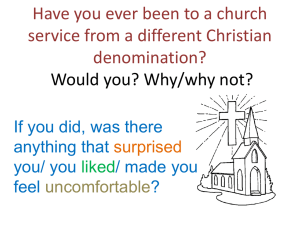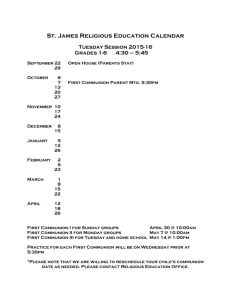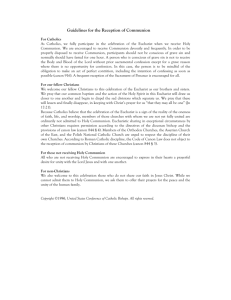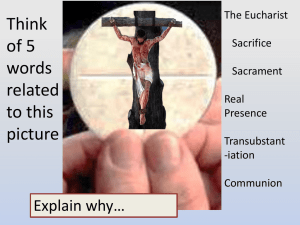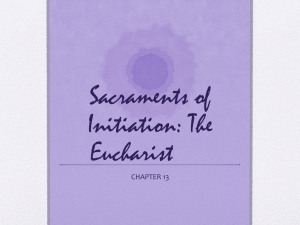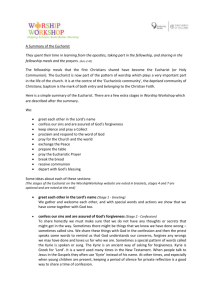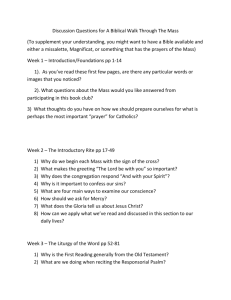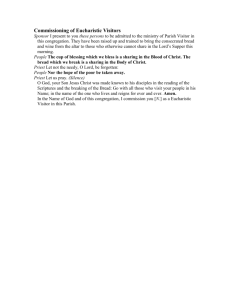Mass and Communion Service What's the Difference
advertisement
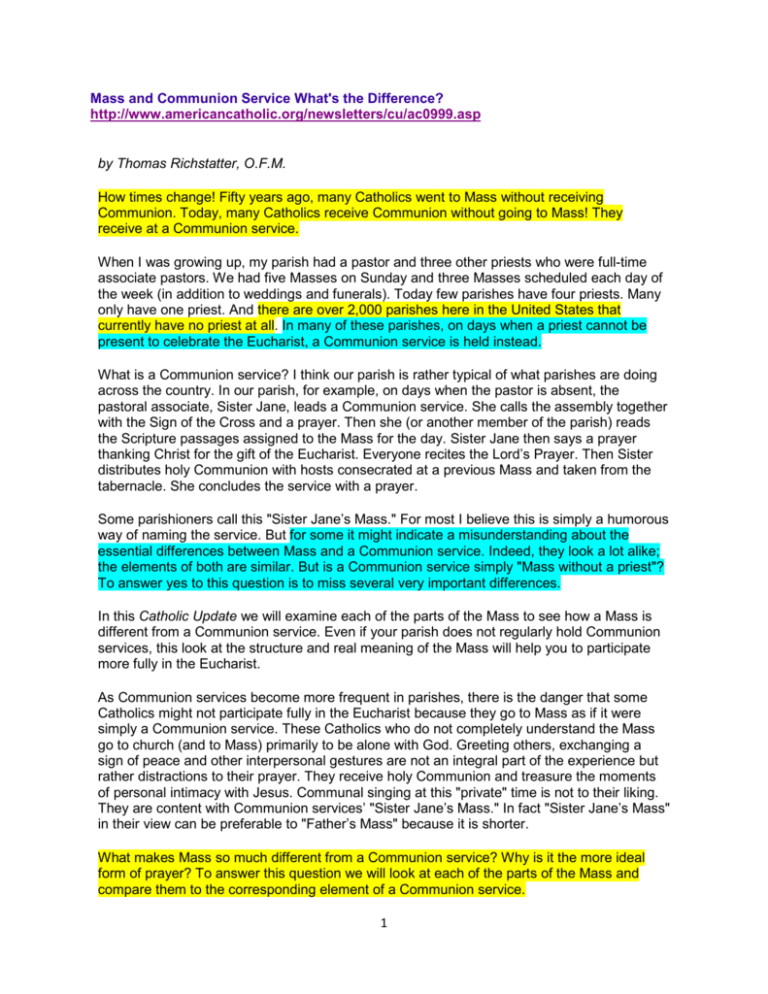
Mass and Communion Service What's the Difference? http://www.americancatholic.org/newsletters/cu/ac0999.asp by Thomas Richstatter, O.F.M. How times change! Fifty years ago, many Catholics went to Mass without receiving Communion. Today, many Catholics receive Communion without going to Mass! They receive at a Communion service. When I was growing up, my parish had a pastor and three other priests who were full-time associate pastors. We had five Masses on Sunday and three Masses scheduled each day of the week (in addition to weddings and funerals). Today few parishes have four priests. Many only have one priest. And there are over 2,000 parishes here in the United States that currently have no priest at all. In many of these parishes, on days when a priest cannot be present to celebrate the Eucharist, a Communion service is held instead. What is a Communion service? I think our parish is rather typical of what parishes are doing across the country. In our parish, for example, on days when the pastor is absent, the pastoral associate, Sister Jane, leads a Communion service. She calls the assembly together with the Sign of the Cross and a prayer. Then she (or another member of the parish) reads the Scripture passages assigned to the Mass for the day. Sister Jane then says a prayer thanking Christ for the gift of the Eucharist. Everyone recites the Lord’s Prayer. Then Sister distributes holy Communion with hosts consecrated at a previous Mass and taken from the tabernacle. She concludes the service with a prayer. Some parishioners call this "Sister Jane’s Mass." For most I believe this is simply a humorous way of naming the service. But for some it might indicate a misunderstanding about the essential differences between Mass and a Communion service. Indeed, they look a lot alike; the elements of both are similar. But is a Communion service simply "Mass without a priest"? To answer yes to this question is to miss several very important differences. In this Catholic Update we will examine each of the parts of the Mass to see how a Mass is different from a Communion service. Even if your parish does not regularly hold Communion services, this look at the structure and real meaning of the Mass will help you to participate more fully in the Eucharist. As Communion services become more frequent in parishes, there is the danger that some Catholics might not participate fully in the Eucharist because they go to Mass as if it were simply a Communion service. These Catholics who do not completely understand the Mass go to church (and to Mass) primarily to be alone with God. Greeting others, exchanging a sign of peace and other interpersonal gestures are not an integral part of the experience but rather distractions to their prayer. They receive holy Communion and treasure the moments of personal intimacy with Jesus. Communal singing at this "private" time is not to their liking. They are content with Communion services’ "Sister Jane’s Mass." In fact "Sister Jane’s Mass" in their view can be preferable to "Father’s Mass" because it is shorter. What makes Mass so much different from a Communion service? Why is it the more ideal form of prayer? To answer this question we will look at each of the parts of the Mass and compare them to the corresponding element of a Communion service. 1 What Happens at Mass? An easy way to understand the parts of the Mass, that is, its external structure or shape, is to compare it to something with which we are all familiar, Thanksgiving dinner at Grandmother’s house. What do we do when we go to Grandmother’s for Thanksgiving? We 1) gather as a family, and 2) talk. We sit in the living room and tell our stories. We catch up on what has happened since the last time we were together. When it’s time to eat, we 3) move to the table. The turkey and all the trimmings are brought from the kitchen and 3a) are placed on the table. We 3b) say grace, and then we pass the food and we 3c) eat and drink. Refreshed by our Thanksgiving meal we 4) say our good-byes and return to our homes. The Eucharist has this same fourfold structure: 1) gathering, 2) storytelling, 3) meal sharing and 4) commissioning. Part three has three movements: 3a) the Preparation of the Gifts, 3b) the Eucharistic Prayer and 3c) the Communion Rite. We gather together When we gather for Eucharist, we do not merely come together in one place at an appointed time, like arriving at a movie theater at 7:00 p.m. because that’s when the movie starts. When we come together for Eucharist, we come at God’s initiative. The Father calls his people together, in the Holy Spirit, to form the Body of the Son. God’s call is voiced through an ordained minister who is (by his ordination) authorized by the Church to speak in the name of the Church (in persona ecclesiae). This is why the priest prays in the first person plural, e.g., "We come to you Father, with praise and thanksgiving..." because he is speaking for all of us. We acknowledge the prayer as our own and give our assent by our "Amen." When Catholics gather for any liturgical service’but this is especially true of the Eucharist ‘they" express in their lives and manifest to others the mystery of Christ and the real nature of the true Church" (Constitution on the Liturgy, #2). Think of a jigsaw puzzle. Even disassembled, the scattered pieces in the box contain the picture. But it is only when the puzzle is assembled and the pieces fitted together that the picture becomes clear. Something similar happens at Eucharist; we are the Body of Christ, but that Body only becomes visible in its fullest sense when we are called together for the liturgy. We gather as a structured community with the pastor overseeing the liturgy, just as he oversees the other dimensions of parish life. At a Communion service, when we are called together by someone who is not authorized to speak in "the name of the Church," we gather as equals. The Eucharist makes the Church become the Church in a way that a Communion service does not. This is a very subtle difference, yet it is very important. To say that a Communion service is simply "Mass without a priest" can overlook the essential role the assembly plays in celebrating the Eucharist. We tell our Story When a Communion service is described as "a Mass without a priest" our attention is drawn to the fact that only the priest has the power "to speak in the name of Christ" in order to consecrate the bread and wine. As wonderful as this is, priesthood involves much more than the "power to consecrate." The first and primary duty of the priest is "to preach the gospel" (Vatican II, The Ministry and Life of Presbyters, #4). 2 The priest speaks not only in the name of Christ (in persona Christi) but also in the name of the Church (in persona ecclesiae). To proclaim the gospel well requires that the pastor live in Christ (that is, be a holy person) and live in the community (that is, know its joys and sorrows, its graces and sins). This is no easy task, but it is at the heart of what it means to be a priest and to preside at the Eucharist. Ordinarily, a Communion service does not have a homily, a liturgical application of the Scripture to the lives of the assembled faithful. But the difference between Mass and a Communion service becomes more evident as we move to the sacrifice and meal dimensions of the Eucharist. We share a Meal At each Eucharist, after we have gathered as Christ’s body and shared our community story, we move to the table to share our community meal. Sharing a meal is different from merely eating food. I live in a house by myself, and I eat food each day, indeed several times a day. But there are times when I invite a friend over and we go out to eat. During the time we spend together sharing dinner, much more happens than simply consuming food. Sharing a meal is much more than eating. Similarly, the Eucharist is much more than receiving holy Communion. Preparation of the Gifts. We bring bread and wine to the altar for the sacrifice of the Mass. In a real but mystical way, the Mass connects us with the sacrifice of Calvary. Throughout his life, Jesus in his humanity lived the prayer: "...not as I will, but as you will" (Matthew 26:39); he constantly strove to be united in mind and heart with the will of the Father. This union with God is achieved and shown in an unsurpassable way in his death and resurrection. The ritual expression of this joyful union with God is at the heart of the meaning of Christian sacrifice. The union with God once achieved by the sprinkling of blood of sacrificial animals has been superseded in the sacrifice of Christ. The purpose of sacrifice has been achieved once and for all by the perfect union of Jesus on the cross with the will of his heavenly Father. We express this sacrifice by our union with God and with one another by sharing the eucharistic meal. At Mass the assembly which, led by the priest, offered the bread and wine and prayed the Eucharistic Prayer, is the same assembly which shares "eucharistized" bread and wine in holy Communion. At a Communion service, on the other hand, the assembly which shares in the sacrament of the Body of Christ is usually distinct from the assembly which first offered the sacrifice. At Mass sacrifice and sacrament are united; at a Communion service the emphasis is on sacrament (as a form of nourishment). This is one of the most important differences between the two rituals. Eucharistic Prayer. The Eucharistic Prayer is the key to understanding the Eucharist and thus the key to understanding the difference between Mass and a Communion service. The shape of the Eucharistic Prayer is that of a berakah. In this traditional Jewish prayer formula we 1) name God, 2) we gratefully remember what God has done for us and then 3) we make our petition. Naming, remembering, petitioning’this is not as complicated or esoteric as it may sound at first. It is basically the same prayer shape or "formula" that a teenager might use on a Saturday evening: "Dad, you’re the best father a guy could ever have. You work hard for us 3 all week long. I bet you want to sit here tonight, rest and watch television. Could I have the keys to the car?" That’s naming, remembering, petitioning. In the Eucharistic Prayer, first we name and bless God, the Father of our Lord Jesus Christ. Second, we remember all that God did to save us through the birth, life, death and resurrection of his son. Third, we ask for the gift of the Spirit. The Holy Spirit filled the human nature of Jesus so that day by day he offered himself to the Father. Now this same Spirit comes upon our gifts of bread and wine and changes them into the Body and Blood of Christ. And this same Holy Spirit comes upon us so that we who eat and drink, who receive holy Communion, become the Body of Christ. The Eucharistic Prayer renews the covenant. In the prayer we acknowledge God’s initiative to unite us to himself in the paschal victory of Christ, and at the same time we acknowledge our sinfulness by asking for the Spirit of unity and reconciliation. The Father has been faithful in the Son. We are not always so faithful, but the Holy Spirit reconciles our infidelity. The covenant is renewed. When we pray "...In memory of his death and resurrection, we offer you, Father, this lifegiving bread, this saving cup..." (Eucharistic Prayer II), we are not just "remembering" in the sense of "thinking about." This is liturgical remembering, a remembering which makes Jesus’ saving love present. For example, when the criminal who was crucified with Jesus asked him, "Remember me when you come into your kingdom," he wasn’t asking Jesus to merely "think about him." This is the "remembering that makes present"‘as we can see from Jesus’ reply: "Amen, I say to you, today you will be with me in Paradise" (Luke 23:42-43). In the Eucharistic Prayer, when we ask God to remember the covenant sealed in the Blood of Jesus, we become present to that covenant. We are joyfully united to God. In our eating and drinking together we are a visible sign of the New Covenant. At a Communion service there is no such Eucharistic Prayer present, but only a Prayer of Thanksgiving. This prayer is often a prayer to Christ thanking him for the gift of the Eucharist. The Eucharistic Prayer, as we have seen, is much more than simply a prayer of thanksgiving for the Eucharist. It is the prayer of Christ (Head and members) to the Father, in the unity of the Holy Spirit, which renews the covenant and places us in holy Communion (union with) God and Communion with one another. Communion Rite. The disciples of Emmaus recounted "how he was made known to them in the breaking of the bread" (Luke 24:35). In this Gospel account the focus of the Eucharistic presence is not so much in the bread as in the sharing of the bread. In the Eucharistic Prayer, we ask that the Father send the Holy Spirit upon the bread and wine to change, to transform, to consecrate the elements into the Body and Blood of Christ. But the prayer does not stop there. It goes on to ask the Father to send the Holy Spirit upon us so that holy Communion might change us, transform us, consecrate us into the Body of Christ. At the Eucharist the Body of Christ gathers to become the Body of Christ. We gather to become who we are. As St. Augustine preached long ago: "Therefore if you yourselves are the body of Christ and his members, then your own mystery lies on the altar...Be what you see, and receive what you are" (Sermon, #272). 4 As the bread and wine become the Body of Christ, so we are to be changed by the Eucharist. Our minds and hearts, week by week, become the mind and heart of Christ. "Have among yourselves the same attitude that is also yours in Christ Jesus..." (Philippians 2:5). God has given us the Eucharist not merely to transform bread and wine, but also to transform lives, to help us to grow into the presence of Christ in our community today, to transform that community into a more inclusive, harmonious, just, compassionate, peaceful, nurturing and Christlike community. At a Communion service, it is possible that those receiving holy Communion are more focused on the individual reception of Christ into their hearts than they are focused on this community dimension of the Eucharist. Sharing the Eucharistic meal is much more than a group of individual Christians receiving holy Communion. Of course, even at Mass, each member of the assembly does not always realize this community dimension of the Eucharist. We go forth The disciples of Emmaus, even though their hearts were burning with love in the presence of the Lord, did not rest in the home in Emmaus. They had received a gift to be shared. They returned in haste to Jerusalem to strengthen the faith of the other disciples. So it is at Mass: Strengthened by our Eucharistic Meal, we go forth to strengthen others. The Spirit who sent Jesus to bring good news to the poor (Luke 4:16-20) now sends us to do the same. The priest who, in the name of the Church, called us together, now, in the name of the Church, commissions us to go forth. Having renewed our covenant relationship with God, we now go forth strengthened to realize God’s plan for the world: to become ambassadors of reconciliation so that all things may come together in Christ. Deeper understanding How times change! When I was ordained in 1966, laypeople were not allowed to even touch the consecrated host, much less lead a Communion service. Now there are more lay ministers than priests giving Communion. Younger Catholics might not realize how radical this change really is. The Roman catechism’issued after the Council of Trent in 1566, which was our official catechism until 1994’taught that only a priest could administer holy Communion: "...to priests alone has been given power to consecrate and administer to the faithful, the holy Eucharist. That this has been the unvarying practice of the Church, that the faithful should receive the Sacrament from the priests,... this practice, as having proceeded from the Apostolic tradition, is to be religiously retained, particularly as Christ the Lord has left us an illustrious example thereof, having consecrated His own most sacred body, and given it to the Apostles with His own hands." This quotation from the Catechism of the Council of Trent is cited by the U. S. bishops’ National Advisory Committee on Adult Religious Education as an example of how some details can change without the basic truth changing. "While core truths do not change, the Church is constantly called to a deeper understanding of those truths. The Church faithfully hands on the teachings of the apostles and, at the same time, remains open to the prompting of the Spirit. Sometimes something is taken to be a core truth [e.g. that lay men and women 5 may not distribute the Eucharist] which the Spirit, through time, eventually teaches us is not" (USCC Publication No. 050-8, p. 5). Indeed it can be difficult to know when something is a "core truth" and when it is not. Although some parishes seem to be moving smoothly and easily from Eucharist to Communion services as the only solution to the priest shortage, some theologians and Church leaders are warning that something essential is being lost here, especially when a parish cannot celebrate the Eucharist on a Sunday. The issue of Sundays without Eucharist is another important topic that needs examination and clarification today. The Lord’s Day has always been celebrated with the Lord’s Supper. Sunday without Eucharist just does not feel like Sunday. The vocation crisis, Sunday without Eucharist, Communion services: These are all related issues. We have looked at some of the differences between Mass and a Communion service. One final difference is this: When we leave the Eucharist, we feel joyful, refreshed and strengthened. We should not be surprised if we leave a Communion service (especially on Sunday when no Mass was celebrated in the parish) with some feeling of unrest and dissatisfaction. We are uneasy because we sense that something is not as it should be. Perhaps this uneasy feeling is a healthy feeling during these changing times. It shows that we have grown in our understanding of what the Mass really is. It is a sign that we must do all we can to keep full celebration of the Eucharist available for everyone. Thomas Richstatter, O.F.M., has a doctorate in sacramental theology from Institut Catholique of Paris and serves on the faculty of St. Meinrad School of Theology. He is a popular writer and lecturer whose latest book is The Sacraments: How Catholics Pray (St. Anthony Messenger Press). 6


